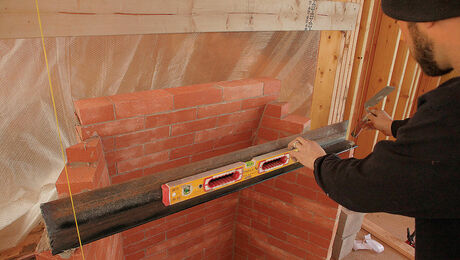Adding additional insulation to ducting
Winter is coming again and I need to correct my duct insulation problem. The sheet metal ducts are in the uninsulated attic and are only insulated to R-5 per code. We get most of our heating needs from a wood stove and generaly use the ductwork to distrbute the hot air from the cathreal peak to other parts of the house via thermal flow. This system works just great, but the thermal drive is a bit to large. In other words we are loosing a lot of heat through the extensive runs of R-5 insulated duct work.
I am interested in adding additional insulation to the ducting and would like some advice on how best to do this. The present insulation is foil covered and taped at all joints. Right now I am considering adding a second layer of R-13 craft faced fiberglass using the paper tabs as a means of stapling one piece to the other. Am I correct in assuming that adding a second layer of moisture barrier will not be a problem because there is no source of moisture? All of the duct seams are well sealed with mastic and the air within the insulation should be relatively static.
Is there a better way of adding insulation? This system is over 50′ long and rather complex. BTW I already realize that the best way is to do it right the first time. It’s too late for me, but future builders might want to add this item to their list of “must do’s”



















Replies
Lou-
While the duct insulation could be the culprit, I'd almost bet that you're suffering from duct leakage. have you checked the ducts with a blower to see how much air is leaking out? While repairing the leaks would require removing the insulation, you may find it worthwhile if you find significant leakage.
Bob
While I have not pressure tested the ducting, I did work with the installer when the system was assembled. As he installed each pre-insulated piece I followed behind him with buckets of duct mastic and sealed each of the connecting joints. I did not seal the folded joints which runs the length of each duct piece because that would have required the removal of the insulation and I did not want to cause him too much interference and/or extra work.
I have been considering using an inclined manometer to determine if operation of the heater fan either increased or decreased the houses internal pressure as a way to determine if I had a significant duct leak and which ducting was leaking or leaking the most. The house is fairly tight but not so tight as to prevent the wood burning stove from drawing well so long as the stove exhaust fan (=/< 1000 cu-ft) is not operating. What do you think of this manometer idea?
Hi What are you trying to insulate? rounds or trunk/rectangular?
Mostly rectangular with a few round branches.
Having some problems with getting a reply to you cause I deleted all the cookies yesterday.
What's the deal with the system is it accessable in attic space? or hanging off ceiling? It would be very easy to add sheet insulation to the flat stock, and depending on how much you need to R ,then its just the thicknes as opposed to using loose batts. As for the rounds you can add to the R-5 by stepping up to the next size insullation If they are 6" with OD of 8" with insul then go to 8" with OD of 10", readily available. Is this kina what you have in mind?
Clay S
Found this post that should be helpfull
From:
DAVERICHESON
Sep-23 5:33 pm
To:
Rachel
(2 of 2)
34963.2 in reply to 34963.1
Foil face dense fiberglass is what we us to retrofit uninsulated ducts. If we don't use a pin spot welder to place the pins we purchase peel and stick pins. Place the pins on the duct and press the f/g insulation down over them. Slip the accompanying washer over the pin and press it into the insulation slightly as you bend the pin over. Use foil tape to seal the joints of the duct before you insulate and at all joints in the insulation.
The peel and stick insulation pins don't have to be used, but sure make the job a lot easier. You don't need to have several extra sets of hands to hold the insulation tight to the duct work. A pair of pins stuck on the top of round ducts acts as an anchor for both ends of the wrap. You should be able to get them at any HVAC supply, or look in the book under industrial insulation supplies.
Never heard of buuble wrap used as insulation except over swiming pools. Must be a left coast thing<G>.
Dave
Edited 9/24/2003 4:40:23 PM ET by Clay
Thanks for the reply. I also noted your attachment about adding pins but I don't think that it would be applicable to my situation as I have a very nicely installed layer of R-5 installed already.
The system is installed on supports about one foot off of the attic floor. the supply duct 14"x22" is just below a same sized return duct. Overall these ducts run about 45' long and the various branches to individual regesters or group of regesters tap off of the the main ducting. The systems design provides not only a path for forced air flow and return, but also as a path for thermal covection flow of heated air drawn off the peak of a wood stove heated room to the other outlying rooms and closets. in operation the design works extreamly well with a measured delta T of only 8 degrees between the heated space and the coolest outlying space ( the mbr closet ).
My present thinking is that I may be giving up too much heat to the outside through some 300 sq-ft of duct surface with only R-5 insulation. Knowing that the thermal flow is driven by the temperature drop in the duct, my intent is to reduce the temp. drop thus reducing the flow rate, but also provide a warmer air flow to the supplied spaces. Net-net result, a warmer space overall.
Maybe I am just thinking to much. I might better spend my time slicing and dicing more firewood for next year.
How bout building a trough for the whole run, say out of like1/4 plywood or some such. then filling it with lose fill insulation, something nice and clean like insullsafe 4 or some other good stuff????????
I also considered this option. Main problems is getting dam material up to the attic, plus what do I do with all of this loose stuff if I ever have to get back into the system. High marks on original thinking though.
Gee, I hope that you were serious and not just pulling my leg. Thanks for the in-put.
I built a two foot catwalk down the center of my attic, then blown loose cell till I reach that catwalk, it covered most of the duct work too.
No leg pulling allowed in the attic. Pre cut strips with good cordless screw gun and should assemble ok. It seems on ocasion I have done a whole house remodel in the attic, I guess that's why they call it work. I sure whish they would call it vacation.
Plus at some point hopefully it will be done and there won't be any going back. And in a worst case senario you could just access the duct and let the loose fill spill to the rest of the attic. That Insullsafe 4 is just like cotton.
Clay
Thank you for a great reply, in fact, thanks to everyone for their help with this "little" project. You are right about the area of my ductwork which is only insulated to R-4. I do not understand why the code people have not addressed this situation. In my case 300-400 sq-ft of R-4 is a huge area with very low insulation.
I am not absolutly sure what you mean when you refer to boots. Would these be like the flexable connections between two pieces, used for alignment and/or vibration isolation? I did not know that thet were being installed between ducting and structure components. In any case I do not have any thing like this in my system. The spaces between the metal ductwork and walls have been sealed with foam. While I am on the subject of sealing openings, is there an inexpensive material which can be used th seal the gaps between my, air-tight, IC rated, cieling cans? These gaps range from 1/8" to upwards of 3/4". I originally wanted to use the high temp caulk that electricians use to seal around top plate penetrations, but at $14 a tube, it's a bit spendy. Now considering using drywall joint compound but that will still only reduce the gaps to a crack.
As I said before, I sealed duct joints as they were being installed Well almost all of them. The first three pieces which come off the bottom of the vertical gas heater and rise up into the attic were installed before I asked the installers how they planned to seal the joints. They dug up a gun with silicone and within a few minutes I knew that I should do the sealing myself. Anyway, the installation completeness and "sealing" of these first joints is highly questionable. This riser is in a very tight corner with two walls and the heater preventing acces to 3 of the 4 sides. Last year I found a large number insect carcasses on the bottom of this riser. I don't know how they got in there but these joints are highly suspect. I plan on cutting an access hole and doing some inspections in the next few weeks.
You may be interested in a story of one of my "great ideas" which had major unintended concequences. I moved to Phoenix and bought a house. Concerned about reducing my summer cooling expenses I thought that it would be a great idea to install a whole house fan in the ceiling of the attached garage. This simple move would have three fantastic money saving features. 1) during just warm weather we could just run the fan with the garage/house door open, and draw air thru the house from open doors/windows. Worked just great. 2) when working in the garage with the garage door open the fan provided a great cooling breeze, Again just great. 3) during the summer I would crack the garage door open about 8" or so, run the fan, and blow the superheated air out of the attic space. Another great feature, right? Wrong! Eight years later, after paying a year round electric bill of about $225/month, I noticed that hot air was blowing into the house from the rough opening when I removed a regester to paint the room. Checked other regesters, same thing. Started pulling switch plates off, same thing. What the heck!!!! Are you laughing yet? My handy-dandy, multifunction, does everything, 5000 cu-ft/min fan was pressurizing the attic and blowing all that superheated air not only out the gable vents, but also into the house! Stopped running that *@%# fan, foamed under the regesters and rubber sealed the electrcal boxes. Result was that averaged out electric bill dropped to $85/month. This sure was a great idea. Lets see, $225 minus $85 equals $140. Over eight years, 96 months, that a difference of $13,440. The only problem is that it came OUT of my checking account. At a cost of $13,440 per "great idea", I now try not to think about things too often, at least without first checking my ideas out with this site.
BTW, about a year after I made these changes, the power company came out and changed-out the meter. Their CFO must have traced the huge drop in the company's income back to my account.
Do you think that I could get this story printed in FHB's Great Moments column?
"You are right about the area of my ductwork which is only insulated to R-4. I do not understand why the code people have not addressed this situation. In my case 300-400 sq-ft of R-4 is a huge area with very low insulation."
It is much worse that just looking at the area.
That is conditioned air so in the summer it might be run in the low 60's or upper 50's. Much larger temp difference.
You experinece in Phoenix is one of the reasons that Buildingscience.com is now recommending that you insulate the bottom of the roof and treat the attic as conditioned space.
And problems with HVAC in the attic are not near as much.
Yes you need to be careful of whole house fans. Most attic venting is meant for normal convection flow from the eves to the roof vents, not for the super high cfm flows that whole house fans crank out. I found this out in a similar fashion. In a small 1920's michigan bungalow I got into the habbit of going upstairs after work and turning on a window fan to cool my bedroom and evacuate the collected hot air. One time I left all the windows and doors shut to the upstairs. A few hours later I went to bed and found my room smelling like the attic. The tar(ish) baking shingle smell. Since the whole upstairs was sealed from the remainder of the house I was drawing attic air into the room to fill the vacumn the fan was causing. My idea of putting a small whole house fan (to keep me from having to do the window fan thing) went down the drain since I would be causing pressure in the attic and pusing the attic air thru the same channels as was found with the window fan. I opted for a gable vent on a thermostat. I have yet to add attic louvers to evac upstairs air but it seems to keep it pretty cool without them.